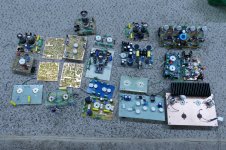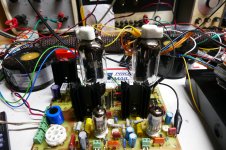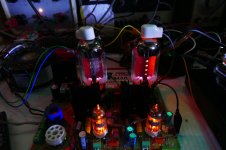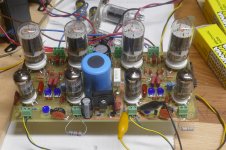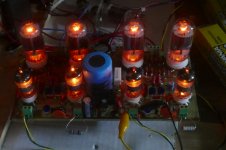The ‘simple’ part of your boards makes it possible for tube noobs like myself to play in arenas we are normally not comfortable in. To that end I have a couple requests or recommendations for new ‘simple’ kits...
The SC (simple circlotron) or SO(TL) designed with a cheap, readily available tube, 10 tubes or less per channel total(maybe a top cap power tube? I like the look). A mono block design would be great, output in the 25-50 watts per channel range? Designed with a (cheap) commercially available (not custom) PT.
The SSP (super simple pre) designed with a common preamp tube (12au7/12at7/6sn7 etc?), cheap readily available PT, 1 tube per channel, minimum parts count (as simple as is practical) designed for any standard input or output devices. Something similar to the 4S universal preamp on DIY audio projects without the design limitations (the 4S has high output imp, vol pot on the output, single tube for both channels)
The TP (tubelab pre) an uncompromising 2 stage pre (1st stage 6sn7, 2nd stage 300b or ?) refined warm large gain range
The SC (simple circlotron) or SO(TL) designed with a cheap, readily available tube, 10 tubes or less per channel total(maybe a top cap power tube? I like the look). A mono block design would be great, output in the 25-50 watts per channel range? Designed with a (cheap) commercially available (not custom) PT.
The SSP (super simple pre) designed with a common preamp tube (12au7/12at7/6sn7 etc?), cheap readily available PT, 1 tube per channel, minimum parts count (as simple as is practical) designed for any standard input or output devices. Something similar to the 4S universal preamp on DIY audio projects without the design limitations (the 4S has high output imp, vol pot on the output, single tube for both channels)
The TP (tubelab pre) an uncompromising 2 stage pre (1st stage 6sn7, 2nd stage 300b or ?) refined warm large gain range
Do you take requests?
I try to keep track of all the possible project ideas that come my way. Unfortunately time and budget restraints limit what turns into a Tubelab product.
The TSE and the SSE were originally amps that I designed and built for myself. Word of mouth local sales led me to build some for my friends, and soon I couldn't build enough so Tubelab was born. The SPP board was a "request" and it does not sell well, probably because it is similar to several existing DIY designs.
Tubelab Inc. has only realized a profit of over $1000 in a calendar year once in its 13 year existence. That wasn't a big deal when I had a fat engineering salary, but Tubelab Inc must pay it's own way now that I am retired and on a fixed income with grandkids to support financially.
I took a contract engineering job 18 months ago and used most of those funds to support Tubelab. Some new hybrid vacuum tube technology was developed, and used in two new amp prototypes worthy of being Tubelab boards. One or two proto board spins would be needed to prove out the design and refine it before about $1000 is spent for commercial quality PC boards.
The financial uncertainty caused by the Coronavirus has killed Tubelab sales in what is usually the best sales time of the year. At this time Tubelab can not spend the $ for any commercial PC board orders. It remains to be seen how the future cash flow prospects evolve.
The SC (simple circlotron)…..readily available tube, 10 tubes or less per channel
Anything with 10 large tubes per channel could not be called "Simple." It would also require a large PC board, which is beyond the size capability of many PCB vendors, and would be expensive. The reality of Tubelab financially is that I should be able to sell enough boards to pay for the batch in a year or two. A big OTL amp would not attract many builders, and would not be a good prospect.
The TP (tubelab pre) an uncompromising 2 stage pre.....I'm not familiar gain structure of tube preamps... is the 2nd stage really required?
Unfortunately the definition of the word "preamp" means several things, has changed over time, and varies with use. In the old days a "preamp" was a multi stage device with several tubes, multiple inputs with a selector switch, tone controls, maybe a tape loop, and possible more than one set of outputs.
Today the SSE, TSE-II and most DIY amps can be connected directly to most common sources like CD players, computer based media players, or other "line level" boxes without needing a preamp. Tone controls have fallen out of fashion with the tube crowd, and those who want them tend toward fancy DSP boxes. The average builder of Tubelab boards just connects their board directly to the source.
Many tube amp builders do listen to vinyl. That requires a "phono stage" or "phono preamp." The phono stage was often included in the preamps of old, and engaged only when playing records due to it's unique frequency de-emphasis curve. The phono stage requires considerable gain with very low hum and noise. Creating a very high quality phono stage with vacuum tubes is difficult, but can be done. It is nearly trivial with a high quality opamp. My personal phono stage is built on a small 2 inch PC board which I mounted INSIDE the turntable. The circuit was taken directly for the National Semi / TI data sheet. I don't believe that a better design could be built with tubes.
The SSP (super simple pre) designed with a common preamp tube.... 6SN7 based preamp would go nice with a TSE-II.
There IS a use for what is usually called a "line stage" or "gain stage" today. I built one for myself on a piece of perf board and is did use a 6SN7 and a couple mosfets.
There are some circumstances where a small amount of gain would be beneficial. This usually involves someone trying to drive an original TSE (slightly lower gain than the TSE-II) to clipping with a digital source, particularly an iPAD or iPhone.
In my setup back in Florida, I had a turntable, a PC, a Technics tuner, a DVD player, and a guitar preamp in my setup and wanted to switch between them. I also had a subwoofer with line inputs, so I needed two outputs with separate level controls.
I built a perfboard device with a 6 input switch, a 6SN7 line stage, and two sets of outputs with their own level controls and mosfet follower buffers for very low output impedance. I used it for several years, and it's still in a box here somewhere. The only changes were more outputs were added to accommodate more amps.....and a big switch box for all the amps to connect to two sets of speakers.
Such a (SSP) device could be made relatively easily if there was really a demand for it. Even a 6SN7 has too much gain, and adding gain to a signal chain ALWAYS adds noise and distortion, so multi stages would not bee useful since the excess gain must be thrown away. It may also be better to use a different tube with lower gain, but some testing would be required.
Just to give you an idea of what makes a Tubelab product, this is a picture of the prototypes that were in a box on my workbench. Some are from the past, dragged out to test an idea, some were used for developing something new.
There are two square boards and a rectangular board with big sweep tubes or sockets, and some turret boards. They were instrumental in developing they hybrid "Composite Electron Device" that allows for running big sweep tubes in triode mode at high voltages.
The blue perf board with 4 sockets was used for testing small CED's.
The blue board on the right that is wired to an older driver PCB with lots of sky wired parts is what the first glimpse of a new working amp design looks like. It is a single channel amp that takes some tiny TV sweep tubes and makes a 50 to 75 watt push pull amp. Both the driver and output stages are CED's.
Above that is the next step, a working stereo amp prototype PCB with it's own power supply. This one makes 50 WPC when powered by a cheap Antek toroid, and 70 WPC with a big Hammond power transformer. I think two more revisions on this board would be needed for it to be ready for commercial quality boards to be made.
Below those is a piece of coper clad board with 4 tube sockets and a heat sink. it is the first prototype of a SE amp that I call UNSET. I use that term because it is a triode mode SET, that contains NO triodes.
The next picture shows the only working stereo UNSET board. It has been hooked up to a pair of speakers since February and gets used often, but not at the tube melting levels seen here when I was exploring it's upper limits (about 40 WPC).
There is also a working push pull amp that used CED's for driver and output stages. All work on it stopped when I had to start on the TSE-II due to the sudden disappearance of all Sharp filament regulator IC's.
Attachments
- Status
- This old topic is closed. If you want to reopen this topic, contact a moderator using the "Report Post" button.
